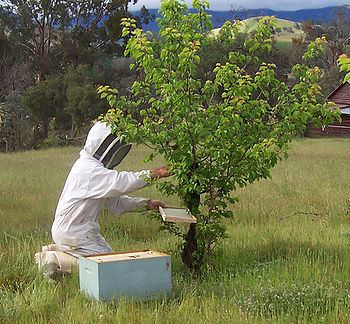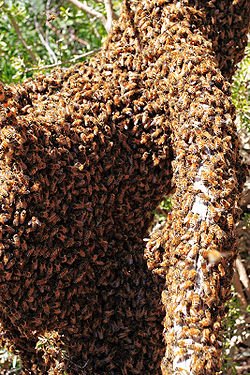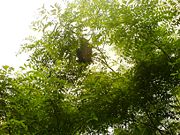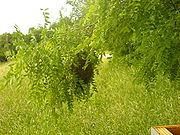
Swarming (honeybee)
Encyclopedia
.jpg)
Honey bee
Honey bees are a subset of bees in the genus Apis, primarily distinguished by the production and storage of honey and the construction of perennial, colonial nests out of wax. Honey bees are the only extant members of the tribe Apini, all in the genus Apis...
colonies. A new honey bee colony is formed when the queen bee
Queen bee
The term queen bee is typically used to refer to an adult, mated female that lives in a honey bee colony or hive; she is usually the mother of most, if not all, the bees in the hive. The queens are developed from larvae selected by worker bees and specially fed in order to become sexually mature...
leaves the colony with a large group of worker bee
Worker bee
A Worker bee is any female eusocial bee that lacks the full reproductive capacity of the colony's queen bee; under most circumstances, this is correlated to an increase in certain non-reproductive activities relative to a queen, as well...
s, a process called swarming. In the prime swarm, about 60% of the worker bees leave the original hive location with the old queen. This swarm can contain thousands to tens of thousands of bees. Swarming is mainly a spring phenomenon, usually within a two- or three-week period depending on the locale, but occasional swarms can happen throughout the producing season.
Secondary afterswarms may happen but are rare. Afterswarms are usually smaller and are accompanied by one or more virgin queens. Sometimes a beehive
Beehive
A beehive is a structure in which bees live and raise their young.Beehive may also refer to:Buildings and locations:* Bee Hive, Alabama, a neighborhood in Alabama* Beehive , a wing of the New Zealand Parliament Buildings...
will swarm in succession until it is almost totally depleted of workers.
Entomologists
Entomology
Entomology is the scientific study of insects, a branch of arthropodology...
consider the colony as a superorganism
Superorganism
A superorganism is an organism consisting of many organisms. This is usually meant to be a social unit of eusocial animals, where division of labour is highly specialised and where individuals are not able to survive by themselves for extended periods of time. Ants are the best-known example of...
. An individual bee without a colony cannot survive for long. The colony also needs a certain colony size to reproduce. In the process of swarming the original single colony reproduces to two and sometimes more colonies.
Swarm behavior

Beekeeper
A beekeeper is a person who keeps honey bees for the purposes of securing commodities such as honey, beeswax, pollen, royal jelly; pollinating fruits and vegetables; raising queens and bees for sale to other farmers; and/or for purposes satisfying natural scientific curiosity...
s are sometimes called to capture swarms that are cast by feral
Feral
A feral organism is one that has changed from being domesticated to being wild or untamed. In the case of plants it is a movement from cultivated to uncultivated or controlled to volunteer. The introduction of feral animals or plants to their non-native regions, like any introduced species, may...
honey bees or from the hives
Beehive (beekeeping)
A beehive is an enclosed structure in which some honey bee species of the subgenus Apis live and raise their young. Natural beehives are naturally occurring structures occupied by honeybee colonies, while domesticated honeybees live in man-made beehives, often in an apiary. These man-made...
of inattentive beekeepers.
Swarm preparation
The worker bees create queen cups throughout the year. When the hive gets ready to swarm the queen lays eggs into the queen cups. New queens are raised and the hive may swarm as soon as the queen cells are capped and before the new virgin queens emerge from their queen cells. A laying queen is too heavy to fly long distances. Therefore, the workers will stop feeding her before the anticipated swarm date and the queen will stop laying eggs. Swarming creates an interruption in the brood cycle of the original colony.During the swarm preparation, scout bees will simply find a nearby location for the swarm to cluster. This intermediate stop is not for permanent habitation and will normally leave within three days to a suitable location. It is from this temporary location that the cluster will determine the final nest site based on the level of excitement of the scout bees.
Nest site selection


Waggle dance
Waggle dance is a term used in beekeeping and ethology for a particular figure-eight dance of the honey bee. By performing this dance, successful foragers can share with their hive mates information about the direction and distance to patches of flowers yielding nectar and pollen, to water...
to indicate direction and distance to others in the cluster. The more excited she is about her findings the more excitedly she dances. If she can convince other scouts to check out the location she found, they may take off, check out the proposed site and promote the site further upon their return. Several different sites may be promoted by different scouts at first. After several hours and sometimes days, slowly a favorite location emerges from this decision making process. When all scouts agree on a final location the whole cluster takes off and flies to it. A swarm may fly a kilometer or more to the scouted location. This collective decision making process is remarkably successful in identifying the most suitable new nest site and keeping the swarm intact. A good nest site has to be large enough to accommodate the swarm (about 15 liters in volume), has to be well protected from the elements, receive a certain amount of warmth from the sun and be not infested with ants.
Swarming creates a vulnerable time in the life of honey bees. Cast swarms are provisioned only with the nectar or honey they carry in their stomachs. A swarm will starve if it does not quickly find a home and more nectar stores. This happens most often with early swarms that are cast on a warm day that is followed by cold or rainy weather in spring. The remnant colony after having cast one or more swarms is usually well provisioned with food, but the new queen can be lost or eaten by predators during her mating flight, or poor weather can prevent her mating flight. In this case the hive has no further young brood to raise additional queens, and it will not survive. As soon as an afterswarm (the second and subsequent swarm after the old queen leaves with the prime swarm) is established at a new location, the bees raise a new queen, or sometimes a replacement virgin queen is already present in the afterswarm.
Africanized bee
Africanized bee
Africanized honey bees, known colloquially as "killer bees", are a hybrid variety of the European honeybee , generated by a man-made breeding of the African honey bee, A. m. scutellata, with various European honey bees such as the Italian bee A. m. ligustica and A. m. iberiensis. These bees are far...
s are notable for their propensity to swarm or abscond. Absconding is a process where the whole hive leaves rather than splits like in swarming. Being tropical bees, they tend to swarm or abscond any time food is scarce, thus making themselves vulnerable in colder locales. Mainly for lack of sufficient winter stores, the africanized bee colonies tend to perish in the winter in higher latitudes.
Swarm management

Beekeeper
A beekeeper is a person who keeps honey bees for the purposes of securing commodities such as honey, beeswax, pollen, royal jelly; pollinating fruits and vegetables; raising queens and bees for sale to other farmers; and/or for purposes satisfying natural scientific curiosity...
"swarm management" in the second year, the hive will cast a "prime swarm" and may cast one to five "after swarms." The old queen will go with the prime swarm, and other swarms will be accompanied by virgin queen
Virgin queen
*In beekeeping, a virgin queen is a queen bee that has not yet mated with a drone.*Elizabeth I of England was also called the Virgin Queen....
s.
It is considered good practice in beekeeping
Beekeeping
Beekeeping is the maintenance of honey bee colonies, commonly in hives, by humans. A beekeeper keeps bees in order to collect honey and other products of the hive , to pollinate crops, or to produce bees for sale to other beekeepers...
to reduce swarming as much as possible using several techniques. Allowing this form of reproduction often results in the loss of the more vigorous division. The remaining colony may be so depleted and set back due to the brood cycle interruption that it is unproductive for the season. Beekeepers control swarming prior to the natural swarm time. They may remove frames
Frame (beehive)
A frame in a beehive is the structural element that holds the honeycomb or brood comb within the hive body . The frame is a key part of the modern "movable" hive since it can be removed in order to inspect the bees for disease or to extract the excess honey.-History:One of first beehive frames was...
of brood comb
Brood comb
The brood comb is the beeswax structure of cells where the queen bee lays eggs. It is the part of the beehive where a new brood is raised by the colony...
making nuc
Nuc
Nucs, or Nucleus Colonies, are small honey bee colonies created from larger colonies. The term refers both to the smaller size box and the colony of honeybees within it....
s (nucleus or starter colonies) or by shaking package bees (usually for sale) from hives.
Swarming is to the beekeeper what losing all of his calves is to a cattleman. Beekeepers try to anticipate swarming and assist the bees to reproduce in a more controlled fashion by "splitting hives" or making "nuc
Nuc
Nucs, or Nucleus Colonies, are small honey bee colonies created from larger colonies. The term refers both to the smaller size box and the colony of honeybees within it....
s." This saves the "calves" and keeps the "cow" in condition to accomplish some work.
Old fashioned laissez-faire
Laissez-faire
In economics, laissez-faire describes an environment in which transactions between private parties are free from state intervention, including restrictive regulations, taxes, tariffs and enforced monopolies....
beekeeping depended upon the capture of swarms to replenish beekeeper colonies and early swarms were especially valued. An old English poem says:
- A swarm of bees in May is worth a load of hay;
- A swarm of bees in June is worth a silver spoon;
- A swarm of bees in July isn't worth a fly.
(Or possibly for the last line, "A swarm of bees in July, let them fly.")
Swarm control methods
Beekeepers that do not wish to increase the number of hives they may use one or more of the many methods for swarm control. Most methods simulate swarming to extinguish the swarming drive.- Clipping one wing of the queen. When one wing of the queen is clipped, a swarm may issue but due to the queen's inability to fly, the swarm will gather right outside the original hive, where the swarm can be easily collected. Even though this is not a swarm prevention method it is a method of swarm retrieval.
- In the Demaree methodDemaree methodThe Demaree method is a term used in beekeeping that describes a swarming prevention method.The method was first published by George Demaree in an article in the American Bee Journal in 1884. It involves separation of the queen from the brood. However, it requires a great deal of labor and...
a frame of capped brood is removed with the old queen. This frame is put in a hive box with empty drawn frames and foundation at the same location of the old hive. A honey super is added to the top of this hive topped by a crown board (known as an "Inner Cover" in America). The remaining hive box sans queen is inspected for queen cells. All queen cells are destroyed. This hive box, which has most of the bees, is put on top of the crown board. Foraging bees will return to the lower box depleting the population of the upper box. After a week to ten days both parts are inspected again and any subsequent queen cells destroyed. After another period of separation the swarming drive is extinguished and the hives can be re-combined. - Simply keep the brood nest open. In preparation for swarming, bees fill the brood nest with honey. The queen stops laying to be trim enough to fly, and her newly unemployed nurse bees go with her. The concept of this method is to open the brood nest to employ those nurse bees and get the queen laying again and redirect this sequence of events. This is done by any number of slight variations from empty frames in the brood nest, frames of bare foundation in the brood nest or drawn combs in the brood nest, or moving brood combs to the box above to cause more expansion of the brood nest.
- Checkerboarding. In the late winter, frames are rearranged above the growing brood nest. The frames above the brood nest are alternated between full honey frames and empty drawn out frames or even foundationless frames. It is believed that only colonies that perceive to have enough reserves will attempt to swarm. Checkerboarding frames above the brood nest apparently destroys this sense of having reserves.
Good beekeepers who are aware that a colony has swarmed will usually add brood with eggs. Given young brood the bees have a second chance to raise a new queen if the first one fails.
Swarm capture
There are various methods to capture a swarm. When the swarm first settles down and forms a cluster it is relatively easy to capture the swarm in a suitable box or nucNuc
Nucs, or Nucleus Colonies, are small honey bee colonies created from larger colonies. The term refers both to the smaller size box and the colony of honeybees within it....
. There are also swarm traps with Nasonov
Nasonov
The Nasonov pheromone is released by worker bees to orient returning forager bees back to the colony. To broadcast this scent, bees raise their abdomens, which contain the Nasonov glands, and fan their wings vigorously....
pheromone lures that can be used to attract swarms. One method that can be employed on a sunny day when the swarm is located on a lower branch or small tree is to put a white sheet under the swarm location. A nuc box is put on the sheet. The swarm is sprayed from the outside with a sugar solution and then vigorously shaken off the branch. The main cluster, hopefully including the queen, will fall onto the white sheet and the bees will quickly go for the first dark entrance space in sight, which is the opening of the nuc. An organized march toward the opening will ensue and after 15 minutes the majority of bees will be inside the nuc. This capture method does not work at night though.
If the swarm is too embroiled in its perch so it cannot be dropped into a box or sheet, a skep can be suspended over it and gentle smoke used to "herd" the swarm into the skep.
Swarms may now be collected by a suction pump and the swarm will be sucked into a box. This way is easy and few bees are lost and none become angry.
Smoke is not recommended to calm a clustered swarm. Smoke will have the opposite effect on a clustered swarm as many bees will become agitated and fly about instead of settling down.
Swarm removal
Encountering a bee swarm for the first time can be alarming. Bees tend to swarm near their hives or honeycombs, so if a swarm is visible then a nest is nearby. Swarms are usually not aggressive unless provoked, so it is important to keep a good distance from the swarm. If the bees feel threatened, they will use their stingers and release a pheromonePheromone
A pheromone is a secreted or excreted chemical factor that triggers a social response in members of the same species. Pheromones are chemicals capable of acting outside the body of the secreting individual to impact the behavior of the receiving individual...
to alert the other bees of the threat resulting in a large bee attack.
Generally, a weak bee colony will not swarm until the colony has produced a larger population of bees. Weak bee colonies can be caused by low food supply, disease such as Foulbrood Disease
American foulbrood
American foulbrood , caused by the spore- forming Paenibacillus larvae ssp. larvae , is the most widespread and destructive of the bee brood diseases. Paenibacillus larvae is a rod-shaped bacterium, which is visible only under a high power microscope...
, or from a queen that produces low quantities of eggs.
Usually a beekeeper or bee removal company will use a bee vacuum to capture the bees in a caged container so they can transport to a bee observation hive. While capturing the bees, smoke is used to calm the bees which makes it safer and easier to remove the colony.
Bee removals are often performed prematurely since bees often rest and swarm in one location for an extended period of time giving the perception that the bees are building a colony. It is a good rule of thumb to wait at least 24 hours before calling a professional to remove the bees.
Bee swarms can almost always be collected alive and relocated by a competent beekeeper or bee removal company. It is a common belief that a bee swarm should always be exterminated for safety reasons, but this is rarely necessary and discouraged if bee removal is possible.

